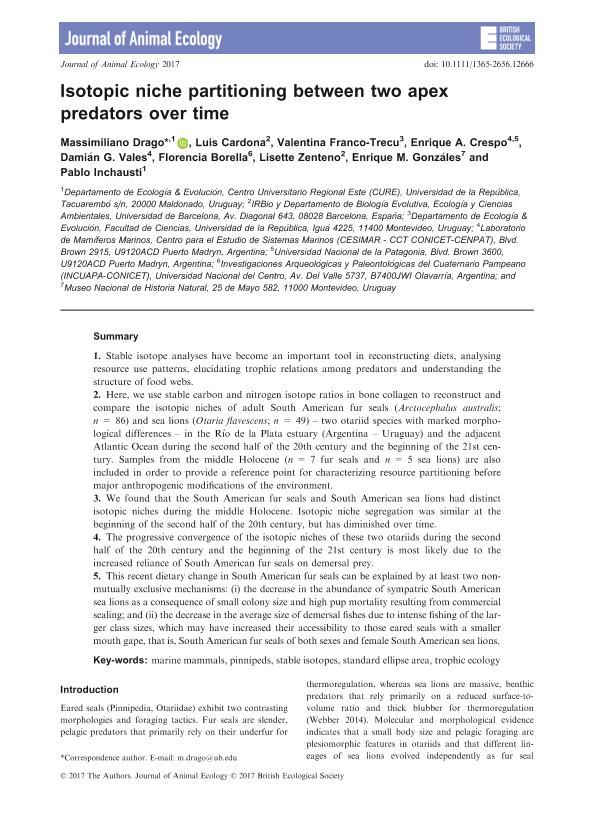Artículo
Isotopic niche partitioning between two apex predators over time
Drago, Massimiliano; Cardona, Luis; Franco Trecu, Valentina; Crespo, Enrique Alberto ; Vales, Damián Gustavo
; Vales, Damián Gustavo ; Borella, Florencia
; Borella, Florencia ; Zenteno, Lisette; Gonzáles, Enrique M.; Inchausti, Pablo
; Zenteno, Lisette; Gonzáles, Enrique M.; Inchausti, Pablo
 ; Vales, Damián Gustavo
; Vales, Damián Gustavo ; Borella, Florencia
; Borella, Florencia ; Zenteno, Lisette; Gonzáles, Enrique M.; Inchausti, Pablo
; Zenteno, Lisette; Gonzáles, Enrique M.; Inchausti, Pablo
Fecha de publicación:
03/2017
Editorial:
Wiley Blackwell Publishing, Inc
Revista:
Journal Of Animal Ecology
ISSN:
0021-8790
Idioma:
Inglés
Tipo de recurso:
Artículo publicado
Clasificación temática:
Resumen
1. Stable isotope analyses have become an important tool in reconstructing diets, analyzing resource use patterns, elucidating trophic relations among predators and understanding the structure of food webs.<br />2. Here, we use stable carbon and nitrogen isotope ratios in bone collagen to reconstruct and compare the isotopic niches of adult South American fur seals (Arctocephalus australis; n = 86) and sea lions (Otaria flavescens; n = 49) ?two otariid species with marked morphological differences? in the Río de la Plata estuary (Argentina - Uruguay) and the adjacent Atlantic Ocean during the second half of the 20th century and the beginning of the 21st century. Samples from the middle Holocene (n = 7 fur seals and n = 5 sea lions) are also included in order to provide a reference point for characterizing resource partitioning before major anthropogenic modifications of the environment.<br />3. We found that the South American fur seals and South American sea lions had distinct isotopic niches during the middle Holocene. Isotopic niche segregation was similar at the beginning of the second half of the 20th century, but has diminished over time.<br />4. The progressive convergence of the isotopic niches of these two otariids during the second half of the 20th century and the beginning of the 21st century is most likely due to the increased reliance of South American fur seals on demersal prey.<br />5. This recent dietary change of South American fur seals can be explained by at least two non-mutually exclusive mechanisms: (i) the decrease in the abundance of sympatric South American sea lions as a consequence of small colony size and high pup mortality resulting from commercial sealing; and (ii) the decrease in the average size of demersal fishes due to intense fishing of the larger class sizes, which may have increased their accessibility to those eared seals with a smaller mouth gape, i.e., South American fur seals of both sexes and female South American sea lions.
Archivos asociados
Licencia
Identificadores
Colecciones
Articulos(CESIMAR)
Articulos de CENTRO PARA EL ESTUDIO DE SISTEMAS MARINOS
Articulos de CENTRO PARA EL ESTUDIO DE SISTEMAS MARINOS
Articulos(INCUAPA)
Articulos de INVESTIGACIONES ARQUEOLOGICAS Y PALEONTOLOGICAS DEL CUATERNARIO PAMPEANO
Articulos de INVESTIGACIONES ARQUEOLOGICAS Y PALEONTOLOGICAS DEL CUATERNARIO PAMPEANO
Citación
Drago, Massimiliano; Cardona, Luis; Franco Trecu, Valentina; Crespo, Enrique Alberto; Vales, Damián Gustavo; et al.; Isotopic niche partitioning between two apex predators over time; Wiley Blackwell Publishing, Inc; Journal Of Animal Ecology; 86; 4; 3-2017; 1-15
Compartir
Altmétricas



